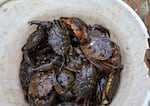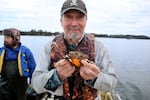
Fisherman Djomar Hora examines a trap used to capture invasive European green crabs just outside the Port of Peninsula harbor in Nahcotta, Wash.
Tom Banse / NW News Network
Shellfish growers in Willapa Bay in southwest Washington, the self-styled “Oyster Capital of the World,” are alarmed by an invasion of potentially destructive nonnative European green crabs. Some are asking for an all-out trapping offensive to corral the invasive species.
The spread of the voracious eaters is a coast-wide concern from northern California to Alaska, but the stakes are particularly high on the productive tidelands alongside the Long Beach Peninsula.
"We need a blitz," said Willapa Bay Shellfish owner Warren Cowell. "This is it, if it's not too late."
Cowell, other local oyster and clam growers and the Shoalwater Bay Tribe are deploying some of their workers part-time to trap and remove the invasive European green crabs. The Washington Department of Fish and Wildlife is providing traps and reimbursing for time and boat fuel.
On a brisk early spring morning, Cowell tagged along with his trapping crew in a 21-foot Boston Whaler to hunt down the invasive species. Crewmembers Djomar Hora and Carlos Hernandez hauled up and emptied dozens of traps placed around the commercial clam and oyster beds offshore of Nahcotta, Washington.
The square traps baited with herring came up filled mostly with juvenile native Dungeness crabs. But sprinkled in were darker colored, mottled green crabs, better recognized by their distinctive shell edges than their variable colors. Hora sorted the catch by hand and tossed the native Dungeness back, all the while trying not to get pinched.

European green crabs are not necessarily green, by the way. They are best identified through their five distinctive spines or toothy notches to the outside of each eye.
Tom Banse / NW News Network
"I have to be careful, especially around the Dungeness. The green crab won't pinch you that hard, but the Dungeness will," Hora said with a knowing laugh.
The crew collected 109 green crabs in less than two hours.
“With over a year of trapping, our numbers are still very high,” Cowell said.
Encouragingly though, it's down from a peak seen last fall. On a couple days in September, Cowell said his crew got more than 2,000 green crabs per day. They deliver each day’s catch to a nearby state Fish and Wildlife Department office freezer to be frozen to death and then sent to a landfill.
Cowell said the state's trapping numbers show this shallow, sheltered saltwater bay has become a hotspot for the invasive green crabs. Another hotspot is Lummi Bay in northwest Washington, where another concerted trapping campaign is underway at a large aquaculture lagoon.
What’s at stake at Willapa Bay
Marine biologists first detected the European green crab on the West Coast in San Francisco Bay in 1989. The invasive shore crab probably arrived from the Atlantic in a ship's ballast water or inadvertently hitchhiked in boxes of bait. Once established in California, currents spread the larvae north in warm water years in the 1990s and 2000s.
Cowell contributes photos and updates to a Facebook group ominously titled, "Willapa Green Crab Disaster."
“They’ll eat all the shellfish if they get established, then move on to everything else that they can eat. All the habitat — the eelgrass which is so important, they even take that out eventually,” Cowell said. “So, what’s at stake here is Willapa Bay as a whole, the whole ecosystem and everything that it contributes.”
According to the Pacific Shellfish Institute, Washington is the nation’s leading producer of oysters, with nearly 70% of those oysters coming from Willapa Bay. Washington is also by far the largest producer of Manila clams in the nation, which is Cowell’s primary product. The shellfish industry is the largest private employer in Pacific County.

Egg-bearing females, like this European green crab held up by clam grower Warren Cowell, can release 200,000 eggs.
Tom Banse / NW News Network
State biologists and the local growers say crab trapping is presently the only way to control the invaders that threaten that bounty.
"We're at the tipping point if we haven’t passed it," Cowell said in an interview on his boat. "We have to trap and trap as aggressively as we possibly can at least to hold the line until we can come up with better solutions.”
The state Fish and Wildlife Department is open to a stepped-up offensive if the community wants it and is prepared to pitch in, said WDFW aquatic invasive species manager Allen Pleus. He said his agency has extra traps to lend and is hiring more seasonal workers this year to protect high value sites. The agency also hired a research scientist to target green crabs.
"This is a problem that is going to persist for a long time," Pleus said. "We’re looking at long term solutions. What are the genetic possibilities, like for creating sterile males or some other method that we could use.”
Pleus said localized control seems possible, but eradication at the statewide level is not a realistic goal because ocean currents are constantly resupplying green crab larvae from afar.
"They get repopulated by larvae coming from the south and coming from the north," he said. "There's just no bottleneck for that larvae."
Green crabs are edible, but culinary demand minimal
While Washington and British Columbia are battling the European crabs — it’s even a governor-declared “emergency” in Washington — Oregon and California’s governments have taken a contrasting approach. The Oregon Department of Fish and Wildlife’s website on crab identification says “green crab are here to stay.” Unlike in Washington, it’s open season year-round in Oregon for recreational crabbers to go after the green crabs, which are edible. The Oregon Department of State Lands a couple of years ago even distributed a guide for how to cook green crabs creatively.
The rub is that the nonnatives have little meat in their shells and do not grow as large as Dungeness crabs. ODFW shellfish program leader Steve Rumrill said green crabs are generating minimal interest from sports fishers.
In the meantime, Rumrill said recent monitoring of Coos, Netarts, Tillamook and Yaquina bays showed the population of invasive green crabs is increasing. Consequently, he said several state agencies are now trying to figure out if Oregon should attempt to knock back "a nascent invasion."
"We're exploring if we should begin an active control effort," Rumrill said in an interview.
Otters, sturgeon, seabirds and other crabs prey on the invasive green crabs, especially when they are small. But Mother Nature doesn’t hold promise as the ultimate control solution because the West Coast’s native predators are not conditioned to hunt and eat the newly arrived crab species in sufficient numbers.
The executive director of the Willapa-Grays Harbor Oyster Growers Association said shellfish production statistics do not show damage from the invasive crabs to date. But David Beugli said there are recent anecdotal reports of poor survival of young Manila clams and oyster spat (aka, seeds) in commercial beds, which could reflect predation by European green crabs. If poor survival past the early stages became a broad trend, he said it wouldn't be seen in harvest statistics for a few years because of the time needed for shellfish to grow to full size.
On Wednesday, U.S. Sen. Patty Murray (D-WA) and Rep. Derek Kilmer (D-WA) are expected to announce an initiative to secure an infusion of federal funding to help West Coast states control green crabs before it’s too late. Murray and Kilmer are scheduled to visit Sequim Bay, where the Jamestown S’Klallam Tribe has deployed traps to claw back the invaders.